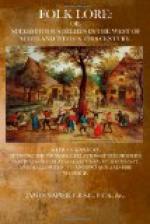Another custom of olden times, and which was continued till the beginning of this century, was that of announcing the death of any person by sending a person with a bell—known as the “deidbell”—through the town or neighbourhood. The same was done to invite to the funeral. In all probability, the custom of ringing the bell had its origin in the church custom, being a call to offer prayers for the soul of the departed. Bell-ringing was also considered a means of keeping away evil spirits. Joseph Train, writing in 1814, refers to another practice common in some parts of Scotland. Whenever the corpse is taken from the house, the bed on which the deceased lay is taken from the house, and all the straw or heather of which it was composed is taken out and burned in a place where no beast can get at it, and in the morning the ashes are carefully examined, believing that the footprint of the next person of the family who will die will be seen. This practice of burning the contents of the bed is commendable for sanitary purposes.
CHAPTER V.
WITCHCRAFT, SECOND-SIGHT, AND THE BLACK ART.
That the devil gave to certain persons supernatural power, which they might exercise at their pleasure, was a belief prevalent throughout all Scotland during the sixteenth and seventeenth centuries. But at the same time this compacting with the devil was reprobated, nay more, was a capital offence, both in civil and ecclesiastical law, and during these two centuries thousands of persons were convicted and executed for this crime. But during the latter part of the seventeenth century the civil courts refused to convict upon the usual evidence, to the great alarm and displeasure of the ecclesiastical authorities, who considered this refusal a great national sin—a direct violation of the law of God, which said—“Thou shalt not suffer a witch to live.” To arrest the punishment which this direct violation of God’s written law was supposed to incur, prayers were offered, and fasts were appointed.
As samples of the kind of evidence on which reputed witches were convicted and executed, I extract the following from the Records of Lanark Presbytery, 1650:—“Likewise he reported that the Commissioners and brethren did find these poynts delated against Janet M’Birnie, one of the suspected women, to wit:
“1st. That on a time the said Janet M’Birnie followed Wm. Brown, sclater, to Robert Williamson’s house in Water Meetings, to crave somewhat, and fell in evil words. After which time, and within four and twenty hours, he fell off ane house and brake his neck.
“2nd. After some outcast between Bessie Achison’s house and Janet M’Birnie’s house, the said Janet M’Birnie prayed that there might be bloody beds and a light house, and after that the said Bessie Achison her daughter took sickness, and the lassie said there is fyre in my bed, and died. And the said Bessie Achison her gudeman dwyned.




